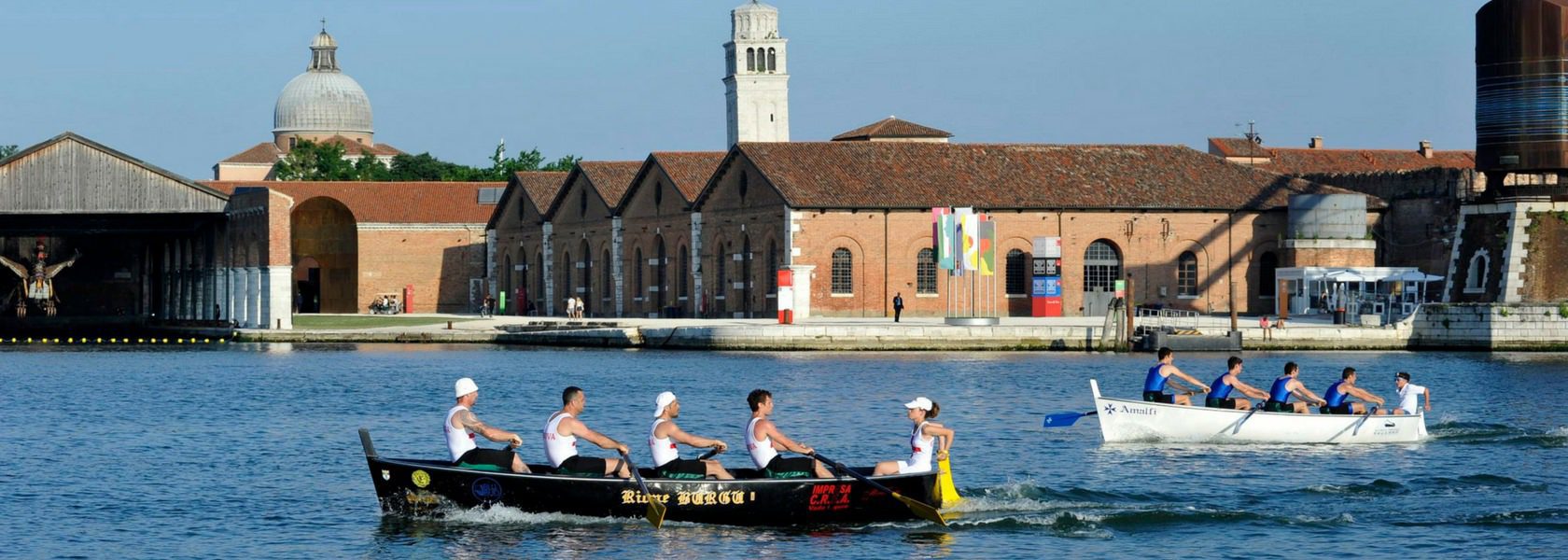
Boats and oares
The original boat, called “Galeone”, was designed and built by the shipwrights of the Cooperativa Gondolieri di Venezia shipyards in 1956. The choice fell on this galley-like craft, one of the many designs proposed by the Citizens’ Committees, because it was well-suited to historical reenactments and along the lines of the ancient ceremonial galleys or feluccas. The standard weight and measurements of the hull and the related tolerances were also set.
The vessel is designed for 8 rowers plus a coxswain, with benches for fixed seat rowing. The hull is in fact divided into eight sections, one for each athlete, with a seat, a footstretcher on which to lock their feet in place, and the oarlocks on the gunwale rotating to offer an efficient rowing stroke. In short, a long cry from the sleek lines of the fast and light craft of modern international sport rowing.
The early wooden craft were high-maintenance, very heavy and their trim and keel space could not easily be adapted to the build and size of the athletes. More often than not, it was the maintenance state of the boats that made a difference, and, even within tolerance limits, their weights varied at each edition, thus giving rise to inevitable controversy.
To put an end to the dispute and level the playing field for all the crews, the first fiberglass hulls were built at the Penco-Vignolo shipyards in Genoa in 1983, revising the size of the seats and footstretchers under the technical direction of the Italian Federation of Fixed-Seat Rowing, in order to allow for a more “comfortable” rowing action. The boats underwent a further evolution in 1994, when the Cantiere Nautico C4 boatyard in Roncade (TV) used new high-tech materials like Kevlar and carbon fiber to make the hull lighter yet very stiff, and therefore much faster.
The standard weight and measurements set for the present-
day galeone are no less than 760 kg including the rudder, the rudder pedals, the benches, the figurehead on the prow, and the so called aftcastle, a sort of protection for the coxswain, on which the banner and emblem of the four cities are displayed.
The length has been set to about 15 meters and the beam is 1.70 metres, while the width of the benches on which the athletes seat must not exceed 23 cm. The benches can be raised or lowered by means of shims, provided they are fastened with the same screw that holds the bench. The foot stretchers or foot plates can be moved forward or aft depending on the height of the athlete, and the oarlocks can have three different positions.
In addition to the colours, a particular feature of these vessels is the figurehead, an ornate prow decoration reminiscent of the city emblem. Until the mid-1980’s, the figurehead was a very heavy and high-maintenance Nowadays, the figureheads are glass fiber replicas, while the originals are precious museum pieces.
Each of the four vessels is characterized by the distinctive colour of the hull and its striking figurehead:
– blue and a winged Horse for Amalfi
– white and a winged Dragon for Genoa
– red and the Eagle for Pisa
– green and the winged Lion for Venice
And while on the subject of the figureheads, an early version of the regatta regulations even set out which part of them should be considered the tip of the boat in case the race came down to a “photo finish”. Quoting verbatim: Amalfi’s boat – the tip of the horse’s front hoof; Genoa’s boat – the tip of the griffin’s nostrils, tongue excluded; Pisa’s boat – the tip of the eagle’s beak; Venice’s boat – midway down the sword (marked with a red ribbon); the forefathers of the regatta knew the multifaceted world of the race participants only too well, and no one would have been surprised if the figureheads had suddenly sprouted an extra-long sword or tongue, or an outsized hoof or nostril.
THE OARS
The oars of the galeone are the classic wooden oars, and their length must not exceed 248 cm, while the blade must be cm. 15.5 wide. They weigh about 6 kg, and they are checked, measured and punch stamped for compliance by the judges before each race.
ANTONIO GIUNTINI, Galeone Rosso. Le Regate delle Repubbliche Marinare – 50 anni di storia. Felici Editore 2007v



